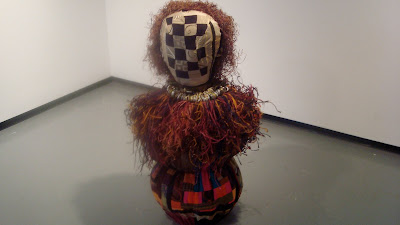TBC: What influenced your collection as a whole?
DB: Well I have 3 main influences, they are the traditional Japanese arashi and shibui technique, the West African masquerade costuming, and the African American southern piecing of stripped piecing of quilts.
TBC: You mentioned the West African Culture, have you been able to visit?
DB: I’ve seen some collections at the Fowler [Museum], particularly they had one of the women of Sierra Leone almost about two years ago. They had a collection of their costumes and their masquerade and their sculpture.
TBC: Can you tell me about the process, how long did it take to create?
DB: This large costume this is kind of the West African Masquerade costume that I was influenced by [points toward the piece in the third picture]. It took some time; I started a portion of it last semester, the fall semester. And I expanded it over the break and a portion of this semester.
TBC: What kind of material did you use?
DB: For this one, there’s raffia, I have some woven yarn, sisal, jute, and natural organic fibers.
TBC: Do you think you might go into the fashion scene, and sell some of the tie-dye pieces?
DB: Yes, I have an interest in textile surface designing which is creating the patterns that go on the fabric.
TBC: Any favorite experiences from creating?
DB: It’s the process, when I began to work with the materials I like to work with the different textures and materials, it’s in the moment.
TBC: So you don’t map it out before hand?
DB: It’s kind of improvisational in a sense. I have a concept. But, it really comes together when I’m actually working.
TBC: Is there anything you want to add that I didn’t cover?
DB: Just, that I enjoyed this.


















































